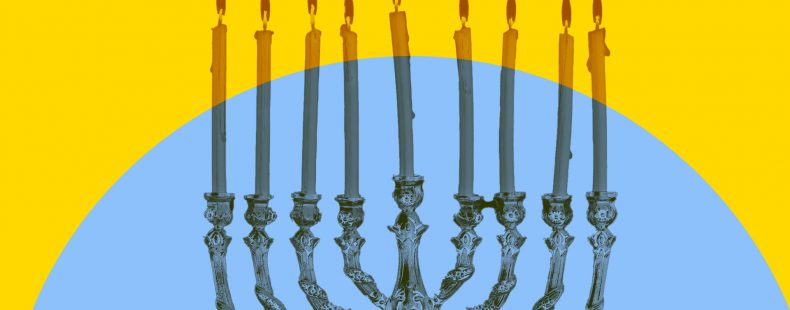Hanukkah (also spelled Chanukah) is one of the most prominent observances during the holiday season in the United States. The eight days of Hanukkah are a time of reflection, celebration, and learning for Jewish people around the world. The holiday is marked by observed rituals, as well as a number of celebratory foods and games that honor Hanukkah’s origin story.
From the ritual of lighting the menorah to the importance of traditional foods and toys, Hanukkah is a holiday with a long history and intricate set of traditions.
What is Hanukkah?
Hanukkah comes from the Hebrew word ḥănukkāh, which literally means “a dedicating.” The name comes from the holiday’s origin story: Hanukkah commemorates the rededication of the Jewish Temple in Jerusalem in the second century BCE.
According to the story in the Torah, Jewish people in Jerusalem fought for three years against the Syrians, who were led by Antiochus IV. Then, around 165 BCE, the Maccabees, led by Judas Maccabaeus, liberated Judea, and Judas ordered that the Temple be restored and cleansed. When the Temple was rededicated, however, it had plenty of lamps but not enough oil.
After liberation, according to the story in the Talmud, there was only a jar with enough oil to light the Temple’s lamps for one day. A miracle permitted the oil to burn for eight days until new consecrated oil was brought in, thus the eight days of Hanukkah.
✡Other names for the holiday
The nicknames for the holiday are also related to the origin story. Hanukkah is sometimes called the Feast of Dedication or, more commonly, the Festival of Lights (or Feast of Lights). This is a reference to the menorah (also called the hanukiah or chanukiah) at the heart of the Hanukkah story and celebrations.
How Hanukkah is celebrated
Lighting the menorah, and the menorah’s connection to the origin of the holiday, is at the heart of Hanukkah celebrations. The menorah is a nine-branched candelabrum. One candle is called the shammes (in Yiddish) or shammāsh (in Hebrew) and is used as a starter to light the other eight. The word shammāsh means “servant” in Hebrew, and this candle is also known as the “helper.” Each evening on the nine days of Hanukkah, one more candle is lit, with special prayers for each lighting.
Early Jewish scholars had two lines of thinking regarding how the lighting should be handled. The scholar Shammai was of the belief that all eight candles should be lit on the first night and then one put out for each night. The scholar Hillel, on the other hand, proposed starting with a single candle and then lighting one more candle each night. Today, Hillel’s method is the one typically followed.
Tradition holds that followers light the menorah just after dark (though on Fridays it’s lit before dark due to Shabbat). The first to get the flame is the shammes that’s typically in the center of the menorah. Families say the Hanukkah recitation that thanks God for his commandments and for performing the original miracle of keeping the oil burning in the rededicated Temple for eight days.
Then the shammes, and only the shammes, is used to light the subsequent candles. But this isn’t done in just any order. On the first night, the candle is placed in the farthest right position and lit. On the second night, the second candle is placed to the left of the first candle, and the person doing the lighting starts with the second candle. The pattern of placing the candles right to left, and then lighting from left to right, is repeated all eight nights.
Outside of the home, rabbis will often use the holiday to teach the scripture and community—along with dedication, Hanukkah also means education.
Food is another important part of observing Hanukkah. Traditional foods echo the importance of oil to the holiday’s origin. Sufganiyot (doughnuts) and latkes (potato pancakes), both oil-fried, are typically enjoyed. Cheese in the form of blintzes (similar to a cheese-filled crepe) and cheese Danishes are also often on the menu. These are in reference to the story of Judith, who tricked a Syrian-Greek soldier into letting his guard down by offering bread, cheese, and wine. Children are usually given chocolate coins in gold foil. These represent gelt, which is Yiddish for money, and the chocolate coins represent charity and giving.
Finally, there are the games. Cards are standard, as are dreidels. These four-sided tops are especially important, and are engraved with the words nes gadol haya sham, which means “a great miracle happened there” (or “a great miracle happened here” on dreidels in Israel).
Learn the best ways to wish someone a very happy Hanukkah here.
When is Hanukkah?
Hanukkah’s date is guided by the Jewish calendar, so the exact date varies on the Gregorian calendar that most Western cultures follow. On the Jewish calendar, Hanukkah spans from the 25th day of the month of Kislev to the second day of the month of Tevet. This generally falls in December on the Gregorian calendar, but not always.
In 2024, Hanukkah starts on the evening of December 25 and ends on the evening of January 2.












